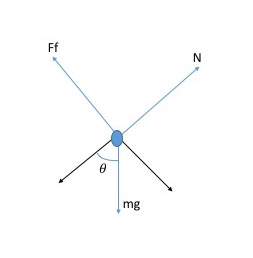Inclined Plane: Difference between revisions
No edit summary |
|||
| Line 5: | Line 5: | ||
===A Mathematical Model=== | ===A Mathematical Model=== | ||
[[File: | [[File:CG1.jpg]] <br> | ||
'''Variables:''' | '''Variables:''' | ||
| Line 24: | Line 24: | ||
:<math>\ F_{net} = F_{net//} + F_{netperp}</math> | :<math>\ F_{net} = F_{net//} + F_{netperp}</math> | ||
:<math>\ F_{net//} = F_f - mgSinθ</math> | :<math>\ F_{net//} = F_f - mgSinθ</math> | ||
:<math>\ F_{netperp} = N -mgCosθ </math> | :<math>\ F_{netperp} = N -mgCosθ </math> | ||
===A Computational Model=== | ===A Computational Model=== | ||
Revision as of 21:50, 28 March 2017
Claimed by Catherine Grey Spring 2017
The Main Idea
We typically know an inclined plane as a flat surface that is higher on one end aka a big triangle. Inclined planes are commonly used to move objects to a higher or lower place. These slopes help to lessen the force needed to move an object but do require the object to move a greater distance, the hypotenuse of the triangular plane. Some examples of inclined planes include ramps, stairs, wedges (such as a door stopper), or even mountains which people sled down.
A Mathematical Model
Variables:
θ = Angle of the plane to the horizontal
g = Acceleration due to gravity
m = Mass of object
N = Normal force (perpendicular to the plane)
Ff = frictional force of the inclined plane (sometimes it is omitted on test problems)
mgSinθ = A force parallel to the plane (mgSinθ > Ff the body slides down the plane)
mgCosθ = A force acting into the plane (opposite to N)
Fnetparallel = The net parallel force acting on the object
Fnetperpendicular = The net perpendicular force acting on the object
Equations:
- [math]\displaystyle{ \ F_{net} = F_{net//} + F_{netperp} }[/math]
- [math]\displaystyle{ \ F_{net//} = F_f - mgSinθ }[/math]
- [math]\displaystyle{ \ F_{netperp} = N -mgCosθ }[/math]
A Computational Model
Technical Usage
Terminology
Let's imagine there is a right triangle. The side opposite to the right angle is a Slant. The side on the bottom is Run The side vertical to the bottom is Rise
Slope: A slope brings a mechanical advantage to the incline plane.
- [math]\displaystyle{ \theta = \tan^{-1} \bigg( \frac {\text{Rise}}{\text{Run}} \bigg) \, }[/math]
Mechanical Advantage
Fw is a gravitational force that applies on the plane
Fi is a force exerted on the object and parallel to the plane
- [math]\displaystyle{ \mathrm{MA} = \frac{F_w}{F_i}. \, }[/math]
if the inclined plane is frictionless,
- [math]\displaystyle{ \text{MA} = \frac{F_w}{F_i} = \frac {1}{\sin \theta} \, }[/math] (in this case, [math]\displaystyle{ \sin \theta = \frac {\text{Rise}}{\text{Length}} \, }[/math])
if the inclined plane has a friction
- [math]\displaystyle{ \mathrm{MA} = \frac {F_w}{F_i} = \frac {\cos \phi} { \sin (\theta - \phi ) } \, }[/math] (in this case, [math]\displaystyle{ \phi = \tan^{-1} \mu \, }[/math])
- [math]\displaystyle{ \theta \lt \phi\, }[/math]: Downhill applied force is needed.
- [math]\displaystyle{ \theta = \phi\, }[/math]: Infinite mechanical advantage.
- [math]\displaystyle{ \theta \gt \phi\, }[/math]: The mechanical advantage is positive. Uphill force is needed.
History
See Also
Free Body Diagram
Normal Force
References
Cole, Matthew (2008). Explore science, 2nd Ed. Pearson Education. https://books.google.com/books?id=RhuciGEQ1G8C&pg=PA178#v=onepage&q&f=false
http://hyperphysics.phy-astr.gsu.edu/hbase/Mechanics/incline.html
